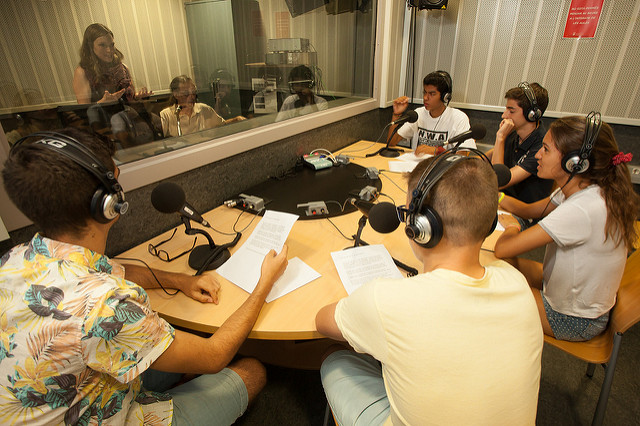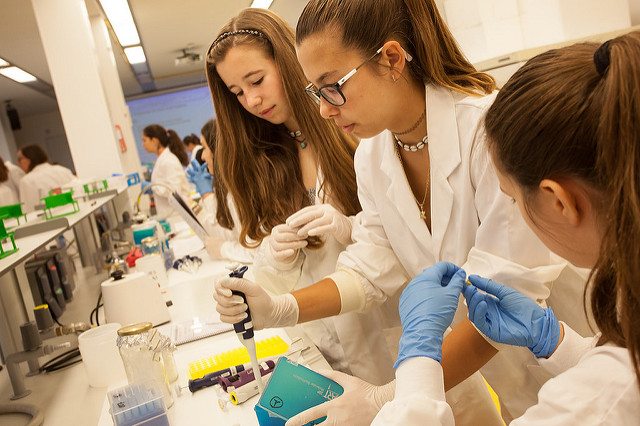Campus Junior opens UPF to secondary school students
Campus Junior opens UPF to secondary school students
Experiential, practical, fun, participatory and experimental are just some of the characteristic of the courses offered as part of UPF’s Campus Júnior, a programme for secondary school students that will hold its fourth edition this summer.
In 2016, Campus Júnior, previously overseen by UPF’s Teaching area, was transferred to the university’s Social Responsibility area. ‘Although the regulations that will reorient it are still pending, we wanted to get a head start this year by bringing the programme into line with our outreach goals, in terms of opening the university up to the local community, the city and the region as whole’, explained Mònica Figueras, vice-rector for Social Responsibility and Promotion at UPF.

According to Figueras, Campus Júnior, which is targeted at students in their third and fourth year of compulsory secondary school (escola secundaria obligatòria or ESO) and first year of upper secondary school (batxillerat), plays an important role as a link between secondary school and university, ‘offering students a first-hand look at the university and giving them more information to help them find and choose a programme and to see whether or not the university is a good fit for their expectations’.
The 2016 edition of the Campus Júnior programme consists of 18 multidisciplinary courses taught by UPF lecturers, each lasting five days, that combine teaching with practical and experimental learning. In addition, participants can discover fields of knowledge that are often largely absent from secondary school curricula and take advantage of the campuses’ facilities and resources.
‘For 2016, we’ve tried to broaden the offer, by involving more programmes at UPF. We’ve also divided the courses more evenly between July and September’, said Figueras. The 2015 edition offered nine courses, with a total of 182 students, 56% more than in 2014. Participants were generally quite pleased with the experience, although many felt that the courses should be longer.
Additionally, ‘this year there will be a number of proposals in the field of social responsibility that were not offered in the previous edition’, the vice-rector explained. Specifically, three new courses have been added: an introduction to Catalan sign language, an engineering and technology course especially aimed at girls, and an introduction to what it means to study at university. This latter course aims to explain to students, in a fun way and through friendly and experiential contexts, what people study at university, how they do it and what it means, as well as to offer them an overview of the skills and abilities specific to higher education.
An introduction to the university’s three campuses

‘Educationally speaking, it is vital for students to be actively involved in the learning process’, explained David Sancho, dean of the Faculty of Political and Social Sciences at UPF, located on the Ciutadella campus, and one of the teachers of the third edition of the course ‘Vols Entendre la Política del Nostre País?’ (Do you want to understand politics in our country?). ‘Our course takes the form of an actual political analysis, allowing students to learn about the administrative and institutional structure of the different powers and what political parties are like’, Sancho explained. To achieve this, the course includes debates, role-playing exercises in which students have to defend a specific position of a given political party, a trip to the Catalan Parliament and a film forum, among other activities.
Marta Narberhaus, a lecturer in the UPF Department of Communications and teacher of the course ‘Fem de Periodistes!’ (Let’s be journalists!), explained that course’s goal. ‘We want to give students the opportunity to immerse themselves in the news world, to learn about everything from basic concepts to how to use the main tools for practicing journalism.’ Students take an in-depth look at the specific features of journalistic language, engage in practical professional simulations (television, radio and Internet) at facilities on the Poblenou campus, and take trips to actual media companies, such as Radio Nacional de España (RNE) or Barcelona Televisió (BTV).
Elsewhere in the city, the university’s Mar campus is home to one of the earliest Campus Júnior courses (it has been offered since the very first edition), called ‘Laboratori de Biologia Molecular’ (Molecular Biology Laboratory). Mar Carrió, a lecturer in the Department of Experimental and Health Sciences (DCEXS), coordinates it. ‘On the one hand, we pose an actual problem, which students have to solve by designing experiments and carrying them out in the lab; on the other, we learn about the research conducted at the Barcelona Biomedical Research Park (PRBB), by talking with the researchers’, she explained. In 2016, Carrió will also be coordinating the first edition of an introductory course to bioinformatics, which will take a similar approach, but using software for the practical portion.
Exploring your surroundings through a lens
‘I got to see Barcelona from a different perspective, through a camera. We visited a lot of new places, and it gave me a chance to enjoy them.’ So said Ralf Merten, a 17-year-old resident of Sant Cugat del Vallès, who participated last summer in the first edition of the course ‘Barcelona Through Your Lens: Urban Landscapes and Photographic Narratives’, which is being offered again this year.
According to Ralf, who wants to study architecture and considers photography to be a ‘cool hobby’, ‘it was fascinating for me to go to a different place each day; you’d be surprised by the kinds of photos you can take depending on the setting!’ He continued, ‘The teachers taught me technical aspects that I didn’t know before, which helped me to take better pictures. My favourite location was the Dipòsit de les Aigües Library at UPF, where I could take pictures of people studying and of the incredible building itself.’
Antoni Luni, who teaches geography in the Department of Humanities at UPF, and Lourdes Delgado, a lecturer at the Image Processing and Multimedia Technology Centre (CITM) at the Polytechnic University of Catalonia (UPC), explained the content of the course, which seeks to depict different landscapes in the city of Barcelona, beyond the historical perspective and that of its artistic and cultural heritage. ‘Every session is divided into two parts, one onsite, where the location is presented to the students, along with an explanation of its importance within the city, and another in the classroom, where students learn about the editing and postproduction process.’
More information
Photo album of Campus Júnior 2015
— https://www.flickr.com/photos/universitatpompeufabra/albums/72157656300593905
